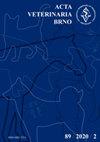The effect of group housing on behaviour, growth performance, and health of dairy calves
IF 0.7
4区 农林科学
Q3 VETERINARY SCIENCES
引用次数: 1
Abstract
The aim of this study was to evaluate the effect of the housing system on the behaviour, performance, and health of dairy calves. The two-year study was conducted on 56 Holstein bull calves (from birth to 60 days of age) that were placed in individual hutches immediately after their birth. At the age of 31 days, 28 bull calves were moved to group hutches by four. The calves were weighed at birth, at 30 days, and at 60 days of age. The starter intake and health were recorded once a day. The behavioural activities of calves (lying, standing and cross-sucking, etc.) were analysed in 24-h cycles at 38 days and 53 days of age. The results showed that group-housed calves spent less time lying and resting (P < 0.01) and more time standing (P < 0.01), receiving the starter (P < 0.05), drinking (P < 0.01), cross-sucking (P < 0.01), and social playing (P < 0.01) compared to individually housed calves. Conversely, calves from individually housing spent more time licking the housing surfaces (P < 0.05) and individual playing (P < 0.05). Bull calves housed from day 31 of age in the group hutches achieved a non-significantly higher body weight at weaning (by +3.0 kg), weight gain (by +2.8 kg), and a significantly higher (P < 0.05) starter intake (by +7.9 kg) compared to the individually housed calves. These results showed that housing in small groups allowed for the natural behaviour of calves and improved their growth without having adverse effects on their health.群体饲养对犊牛行为、生长性能和健康的影响
本研究的目的是评估圈舍系统对奶牛犊牛行为、生产性能和健康的影响。这项为期两年的研究对56头荷斯坦公牛(从出生到60日龄)进行了研究,这些公牛在出生后立即被放在单独的笼子里。在31日龄时,28头公牛以4头为单位被移至群仓。小牛在出生时、30日龄和60日龄时称重。每天记录一次发酵剂摄入量和健康状况。在38日龄和53日龄时,以24小时为周期分析犊牛的行为活动(躺卧、站立和交叉吸吮等)。结果表明:与单独圈养犊牛相比,群养犊牛躺卧和休息时间较少(P < 0.01),站立时间较多(P < 0.01),进食(P < 0.05)、饮水(P < 0.01)、交叉吸吮(P < 0.01)和社交玩耍时间较多(P < 0.01);相反,单独饲养的犊牛舔窝表面(P < 0.05)和单独玩耍的时间更多(P < 0.05)。与单独饲养的犊牛相比,31日龄起在组合饲养的犊牛断奶体重(+3.0 kg)和增重(+2.8 kg)均显著增加(P < 0.05),犊牛采食量(+7.9 kg)显著增加(P < 0.05)。这些结果表明,小团体的住房允许小牛的自然行为,并促进它们的生长,而不会对它们的健康产生不利影响。
本文章由计算机程序翻译,如有差异,请以英文原文为准。
求助全文
约1分钟内获得全文
求助全文
来源期刊

Acta Veterinaria Brno
农林科学-兽医学
CiteScore
1.00
自引率
33.30%
发文量
36
审稿时长
18-36 weeks
期刊介绍:
ACTA VETERINARIA BRNO is a scientific journal of the University of Veterinary and Pharmaceutical Sciences in Brno, Czech Republic.
The scientific journal Acta Veterinaria Brno is dedicated to the publication of original research findings and clinical observations in veterinary and biomedical sciences. Original scientific research articles reporting new and substantial contribution to veterinary science and original methods that have not been submitted for publication elsewhere are considered for publication. A written statement to this effect should accompany the manuscript, along with approval for publication by the author´s head of department. The authors bear full responsibility for the contents of their contribution. Book reviews are published, too.
 求助内容:
求助内容: 应助结果提醒方式:
应助结果提醒方式:


